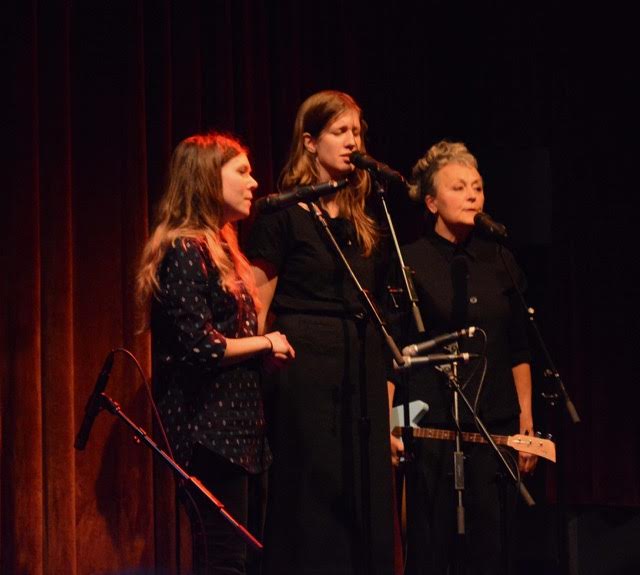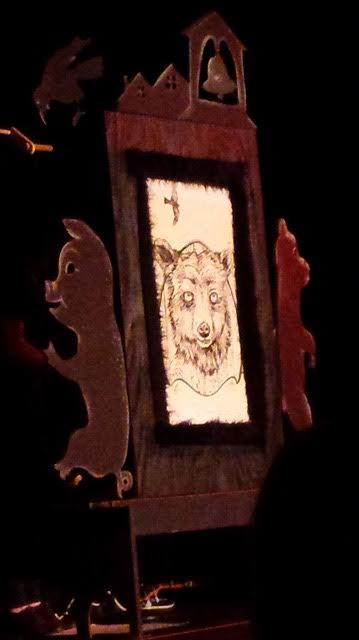(above photo: A Crankie by Katherine Fahey)
Baltimore’s Crankie Fest at Creative Alliance is fertile ground for the revival of an old storytelling art form by Kara McDonagh
In a theater packed to capacity for the second night, the audience for Baltimore’s Third Annual Crankie Festival found a refuge from the onslaught of images galloping across our ubiquitous screens. The evening was a mesmerizing lullaby beckoning us towards wonder. There, the lilting and dark undertones of mountain and other traditional music set the score for the night’s dreamlike circus troop of crankie acts.
Even in a time of unprecedented availability of digital stories replete with painstakingly produced visual effects and soundtracks, these handmade picture story songs were ripe with the capacity to enthrall. What is it about them that produced this reverie in the crowd? How did they knit us into a wide-eyed clan of lost boys gathered around Wendy at bedtime?
 Anna and Elizabeth, with Liz Downing : Photo Credit Jon Bolton
Anna and Elizabeth, with Liz Downing : Photo Credit Jon Bolton
Perhaps it has to do with the pace set by the crankie, which has been described as a “scrolling mural,” a “cranked scrolling storytelling device in a box,” and a “paper movie.” While not all of the acts in the crankie festival involved turning the scroll to reveal the unfolding narrative, the tone set by the medium and the musicians highlighted the elasticity of time – the ability to wind and unwind time – to bring the past into the present, to retrieve what was important that may have been lost or forgotten, and to reflect on what has passed with patience, with humor, and with reverence.
There was a remarkable range of interpretations of the art form in this year’s festival. The selections ranged from a simple wooden box housing a scroll that depicted characters in a lone storyteller’s narrative to an elaborate multi-storied doll house where the illustration that scrolled was the environment behind the wooden eyed windows. The festival included crankies accompanied by recordings of oral histories, banjo music, folk ballads, and projections and ended with a magical shadow puppet story song with multiple screens and artists, musicians, puppeteers, and performers weaving a lyrical symphony of images.
 McKenzie Elizabeth Ditter accompanied by Matt Muirhead, Sue Truman, and Laura Kalman : Photo Credit Jon Bolton
McKenzie Elizabeth Ditter accompanied by Matt Muirhead, Sue Truman, and Laura Kalman : Photo Credit Jon Bolton
Crankie’s uncoiled cousins made appearances as well; an illuminated diorama of rowhomes (built by Lisa Hillring and performed by Aaron Henkin and Wendel Patrick) with video images and interviews from the WYPR radio show “Out of the Blocks” paired with live jazz, a cantastoria (predecessor to the crankie – sort of an easel pad of paintings that are folded back as the story is told) with an accordion-playing storyteller who punctuated her story with illustrative dance moves, and a roll of densely intricate papercuts slid over an overhead projector. Many of the artists borrowed the tools of today – handheld cameras, projections, laptops, and recordings – as a complement to their creations, not in place of humans but in partnership with them.

Clare Dolan, Cantasoria : Photo Credit Kara McDonagh
The crankies are an avenue for themes that you can’t think about fast, things it helps to think about over time, subjects to chew slowly and then digest, those that are animated to the musical hypnotism of the unhurried. A highway is a wonderful thing when you’ve got to get there fast, but some meanings need a story to take the long way through the dirt road.
Anna and Elizabeth’s fiddling and storytelling work in tandem with the ambient crinkle of the ricepaper moving its way through scrolls of the crankie to illuminate the story of a woman fiddler from Kentucky, through an old woman’s eyes made childlike with memory. Her memories are elevated through the uncomplicated wooden frame, sparse silhouetted figures, simple illumination, and the human effort needed for the arc of the story to unfold. The result creates an intimate portrait of the fruits of an unconventional woman musician’s life, a life full of community and music still reverberating with meaning for those who grew up in her graces.
Lest we ignore the stories of childhood that encompass more than the sparks of wonder or the warmth of community, a sampling of the evening’s crankies led us compellingly into the mystery, curiosity, and danger inherent in the vulnerability of naivete. The closing piece in the festival, “I Know Moonlight” was a thoughtful and epic production that invited reflection on the ghosts one inherits and the seduction of their siren song. Katherine Fahey’s delicate yet declarative hand cut tissue paper and Tyvek images paired with the acoustic accompaniment of Caleb Stine lured the viewer through the narrative as steadily as the protagonist in the story made his way to an inevitable encounter, and reckoning, with the forbidden.
The theatricality of the piece was heightened by the intermittent murmur created with the shadow shape visitations puppeteered by Valeska Populoh appearing from behind the translucent paper of the crankie. When the silhouette of Sabine Kearley, the epitome of the allure of youth, appears on a large screen and contributes her haunting wistful song the story’s theme of the shifting nature of the line between illusion and reality gains dimension. As the performers fed us notes, images, light, shadow and movement against the backdrop of the hand turning the wooden crank, the circle – the slow moving continuous circle of the story – finds the shape of our thoughts and myth is made manifest.
The crankies as a collection – the diversity of the art objects and the music, stories, and performers that animated the devices – created palpable delight in the audience that grew throughout the night. The high trill of Liz Downing’s drawl and the swish of the paper through the scrolls resuscitated our child’s eyes that still see and remember the days with mama when we were young and lost but still strangers to the vicissitudes of grief. Her bureau altar crankie embellished with cardboard cutouts, the intricate drawings of angels, and of the languid eyes of a taxidermied bear cast an ‘open sesame’ spell to the melancholy wisdom of the innocents that can’t be chased down or hunted. It can only be lured out slowly through the senses.
 Liz Downing’s Crankie : Photo Credit Kara McDonagh
Liz Downing’s Crankie : Photo Credit Kara McDonagh
The festival is undoubtedly suffused with the sensibility of its founders and hosts, Anna and Elizabeth, a multitalented pair of musical collaborators whose artistic lifeblood stems from Appalachian mountain music and culture. The rich representation of ballads, instrumentals, and oral histories appear to be part of the festival’s DNA. In other places, like parts of Vermont where crankies are reportedly more widely understood as an art form and storytelling device, the crankies may have a more distinctly activist edge.
This is probably at least in part due to the influence of Bread and Puppet Theatre and their 50 year history rooted in experimental theatre, radical counterculture, art, and activism. Crankies, with their accessibility, interactivity, and potential for unique collaborations between artistic disciplines, hold great promise as a fruitful avenue to highlight more of Baltimore’s own unique homegrown hybrid stories.
With the festival growing in popularity and with crankie and cantastoria making workshops at the Creative Alliance, the North Avenue Knowledge Exchange, and in Baltimore City schools, it seems likely that the festival will provide an evolving home for an increasingly diverse, prolific, and sophisticated Baltimore crankie artist community.
<><><><><><><>
Learn more about crankies and the artists at this year’s festival. See links below:
- thecrankiefactory.com (Sue Truman’s historical website)
- http://wypr.org/term/out-blocks (more info on row home piece)
- annaandelizabeth.com (hosts of the show)
- lizdowningart.com
- katherinefahey.com
- mckenzieelizabeth.co
- http://bannersandcranks.org (Clare Dolan’s project)
Make your own crankie with Katherine Fahey @ The Creative Alliance
<><><><><><><>
Author Kara McDonagh is always looking for the spaces where the arts & culture, community building, and struggles for justice intersect. Her contribution in those spaces has included work as an artist, organizer, program creator, matchmaker of people and resources, coach, advocate, writer and supporter. She was formerly the founding Director of the Community Art Corps & faculty in the MA. In Community Art program at MICA & currently works with national Tribal youth leadership development efforts and with the creation of training and technical assistance for programs for Tribal youth.






